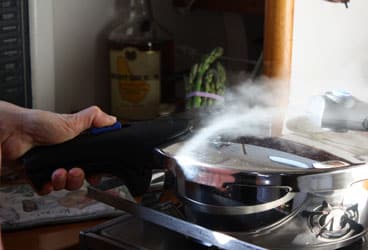
Pressure Cooker
Pressure cookers are the salvation of many a cruising galley, to be sure. I’ve always admired them—from a distance. And so have my cruising brethren, some of whom admit that the noise, steam, and horrific tales of exploding pots and beans sprayed all over the saloon is a major turnoff. So many other things go wrong on boats already, why add to the list?
Thanks to a modern and convenient design from Germany that incorporates several impressive and quiet safety features, I’m happy to report back that after trying one out, my thinking on the topic is under revision.
What’s generally known and accepted about pressure cooking is that it’s a quicker method that allows food to retain nutritional value more than it would if cooked via conventional methods. This is because increasing pressure while using less liquid in a sealed cooker expels oxygen and decreases the amount of vitamins and nutrients lost in the process. The added boon for the average cruising boat is that less cooking time translates into fuel savings.
As well, if you don’t have onboard refrigeration or enough room in the reefer, foods cooked in a pressure cooker and sealed inside with the cap still on remain sterile. Just reheat, says longtime bluewater voyager, cook, and author Amanda Swan-Neal. “Repressuring before eating kills most organisms,” she says. “This process works well for meats or if you catch a large fish and don’t have refrigeration.”
The Blue Point Pressure Pan from Fissler of Germany has added innovation to the basic principles of the genre, and the result is a high-quality 18/10 stainless-steel pan that’s impressive whether used for pressure or for conventional cooking.
**
The Tryout**
Easter presented the perfect occasion for testing the Blue Point, so named for the color of the cooking indicator that lets you monitor temperatures so you can adjust the stove. After a bit of deliberation over the menu, my partner, Rick Martell, and I settled on a feast of ham, sweet potatoes, and asparagus aboard Land’s End, our Crocker ketch. We decided that while the ham warmed up in the galley’s oven, a Gas Systems design, we’d cook the potatoes and vegetables in the pressure pan on its stove top.
Before we headed to the grocery store, we did our homework and spent some time studying the user’s guide, as should anyone who buys one of these cookers. Interesting to us was the feature that Fissler has incorporated into the handle, a valve that you slide to release pressure. Gone are the days when you simply had to wait for the temperature to drop and the pot to cool off.
Safety features include a residual pressure block that keeps the cooker closed until it’s been completely depressurized. Another safety item is that the pressure can only start to build if the interlocking lid is snapped in correctly. What we also liked about the Fissler is that the handle fits comfortably above the stove safety rail; we can’t say that about every pan we’ve brought aboard, and it’s a welcome feature.
Once we felt that we’d grasped the instructions, we put the pan to the test with sweet potatoes and asparagus. We carefully monitored the movement of the blue temperature indicator, and we timed the cooking so the potatoes were nearly done before we turned off the heat, released the pressure, unlocked the lid, added the asparagus, resealed the lid, and turned up the heat again.
It took us no longer than 20 minutes to thoroughly cook five large sweet potatoes and a tender batch of asparagus. They were perfect complements to the juicy ham, and the meal overall left a fresh taste in our mouths that said “springtime.”
Elaine Lembo, CW_’s deputy editor, is now a convert to pressure cooking._
Pressure-Cooking Resources
The Fissler Blue Point Pressure Pan is available for US$260 at the Fissler website (fisslerusa.com). For insight into cooking with pressure, see The Essential Galley Companion by Amanda Swan Neal ($30; 2000; Mahina Expeditions, www.mahina.com) and the 20th-anniversary edition of Cooking Under Pressure by
Lorna J. Sass ($24; 2009; William Morrow Cookbooks).








